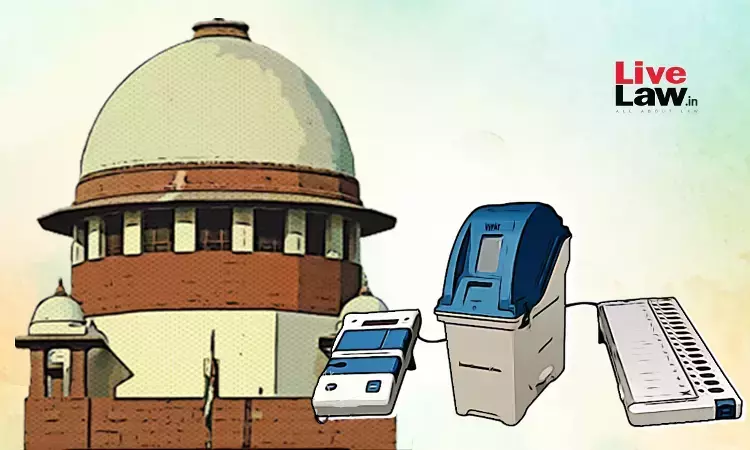A Landmark Verdict Shapes Electoral Procedures
In a pivotal ruling, the Supreme Court, on April 26, dismissed petitions advocating for a 100% cross-verification of Electronic Voting Machines (EVMs) data with Voter Verifiable Paper Audit Trail (VVPAT) records. This decision, delivered by Justices Sanjiv Khanna and Dipankar Datta, marks a significant milestone in electoral jurisprudence, influencing the conduct of future elections.
Upholding Integrity: Supreme Court’s Stance on Plea Rejection
The Supreme Court, after meticulous deliberation, has declined the pleas urging comprehensive EVM-VVPAT verification, opting to maintain the existing protocol. Justice Khanna elucidated the rationale behind the rejection, citing technical considerations, established procedures, and evidential analysis.
Key Directions Issued by the Bench
Despite rejecting the plea for universal verification, the apex court issued two crucial directives to fortify electoral integrity:
Sealing of Symbol Loading Unit (SLU)
- Following the symbol loading process in VVPATs, commencing May 1, 2024, the Symbol Loading Unit (SLU) shall be meticulously sealed and safeguarded in containers.
- Candidates or their representatives are mandated to endorse the seals, ensuring accountability and transparency.
- The sealed containers, housing the SLUs, will be stored alongside EVMs for a minimum of 45 days post-results declaration, subject to examination akin to EVMs.
Post-Election Verification of Burnt Memory Semi-Controllers
- A meticulous examination of burnt memory semi-controllers in 5% of EVMs per assembly segment shall be conducted post-results announcement.
- Candidates at serial number 2 or 3 behind the highest polled candidate reserve the right to request verification.
- District Election Officers, in conjunction with engineers, will certify the integrity of the burnt memory microcontroller.
- Candidates bearing expenses for verification will be reimbursed if tampering is detected, underscoring accountability and fairness.
Suggestions for Enhanced Electoral Mechanisms
In addition to the directives, the bench advised the Election Commission of India (ECI) to explore technological innovations, such as electronic machines for VVPAT slip counting and integration of barcodes for party identification, augmenting efficiency and transparency in the electoral process.
Justice Datta’s Insights: Balancing Skepticism with Constructive Evaluation
Justice Datta, in his supplementary remarks, emphasized the importance of balanced scrutiny in assessing electoral systems. He cautioned against undue skepticism, advocating for evidence-based evaluation to foster credibility and progress.
Impact and Timeliness of the Verdict
The pronouncement of the judgment coincides with the onset of phase 2 of Lok Sabha Elections 2024, underscoring its immediate relevance and impact on electoral proceedings.
Background: Petitions and Counterarguments
The petitions, filed by prominent entities including the Association for Democratic Reforms, articulated concerns regarding the current verification procedures and advocated for comprehensive reforms. However, the Election Commission countered these arguments, asserting the reliability of existing mechanisms and highlighting logistical challenges associated with universal verification.
FAQs: Clarifying Key Queries
- Why did the Supreme Court reject the plea for 100% verification?
- The rejection stemmed from a comprehensive assessment of technical intricacies, established protocols, and evidentiary considerations, prioritizing electoral integrity while balancing logistical realities.
- What are the implications of the directives issued by the Supreme Court?
- The directives aim to fortify electoral processes by enhancing transparency, accountability, and post-election scrutiny, ensuring integrity and fairness in the electoral ecosystem.
- How will the verification of burnt memory semi-controllers be conducted?
- Post-results announcement, a meticulous examination of burnt memory semi-controllers in 5% of EVMs per assembly segment will be undertaken, facilitated by engineers and overseen by District Election Officers to certify authenticity.
- What measures did the petitioners advocate for?
- The petitioners sought universal verification of VVPATs, contending that it ensures accurate representation of voter intent and strengthens democratic processes.
- What are the logistical challenges associated with universal verification?
- Counting all VVPAT paper slips manually was deemed labor-intensive and susceptible to human error, as argued by the Election Commission, highlighting the practical complexities of implementing universal verification.
- How does the verdict align with electoral transparency and accountability?
- While rejecting universal verification, the Supreme Court’s directives emphasize post-election scrutiny and transparency measures, striking a balance between electoral integrity and logistical feasibility.
Conclusion: Upholding Electoral Integrity Through Prudent Adjudication
The Supreme Court’s verdict, rejecting the plea for 100% EVM-VVPAT verification while issuing directives to enhance post-election scrutiny, underscores its commitment to upholding electoral integrity. By striking a balance between skepticism and evidence-based evaluation, the apex court navigates the complex terrain of electoral jurisprudence, fostering trust and credibility in democratic processes.
Stay updated with all the insights.
Navigate news, 1 email day.
Subscribe to Qrius

